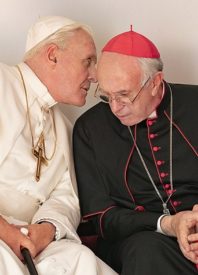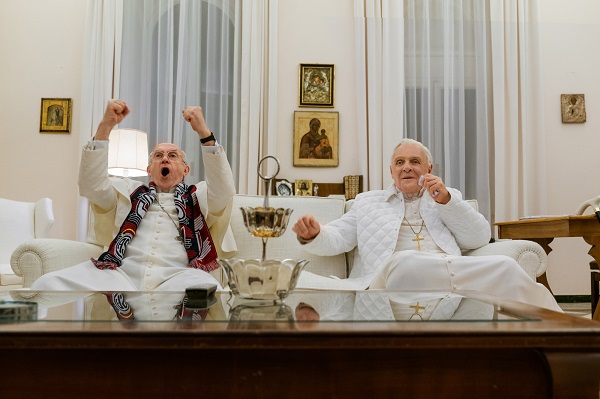
I read other critics’ reviews of Fernando Meirelles’ The Two Popes. And those pieces remind me that the film only speculates on its two main characters. Despite that caveat, the film competently argues that its version of history is legitimate enough. It also questions its audiences’ individual perspectives and biases for or against these two men. The film depicts fictional versions of Pope Benedict XVI, then Cardinal Ratzinger (Anthony Hopkins) and Cardinal Bergoglio (Jonathan Pryce). They first meet in a bathroom before entering a conclave. That conclave determines who the next Pope is after John Paul II dies. It then shows their second set of meetings, which take up most of the running time.
In showing these meetings between Benedict and Bergoglio, we expect a clash between two powerful men. But what they’re asking of each other doesn’t demand total victory against the other. Bergoglio asks Benedict for a retirement, which is reasonable for a man in his sixties to ask of his superior. Benedict, however, has a more unusual request. Benedict also wants to resign from the Papacy. He wouldn’t be the first pope to do so. He would also reunite all the cardinals into another conclave, taking a calculated risk. That they would vote in the cardinal with the second highest amount of votes during the last conclave – Bergoglio.
Like some liberal lapsed Catholics, I came into this film knowing Benedict’s story. Benedict, like most German kids during the war, joined the Hitler Youth. He eventually grew up to be an adult German Pope. He then relinquished being the sixth most powerful person in the world because his assistant is a pedophile. The film omits the fact that he also faced and defrocked pedophile priests every other day. It’s part of any job that would destroy any person. Pope Benedict is a figure with a complexity that this film doesn’t explore. But The Two Popes instead explores the complex qualities and history of our current Pope Francis. And it makes sense that a director like Meirelles from South America is on the helm for such plans. Bergoglio comes from Argentina, a country with a history that he himself played a part he considers dirty.
Meirelles and screenwriter Anthony McCarten then explores Bergoglio’s history in two hours. The bleached colors of contemporary Vatican City are constant. But in depicting sixty years of both a man and his country, they switch between black and white and sepiatone. The country, under the film’s perspective, is capable of vibrancy and desolation. Bergoglio performs a mass in the streets of Buenos Aires, his sermons echoing across walls with graffiti. But while he’s in the Vatican, he remembers the country’s mountains. And the film eventually shows what those mountains mean to him. As a place where the Jesuit order exiled him for making a political miscalculation. A miscalculation so grave that it makes him think he’s not worthy of being a cardinal.
Other than the fact that it doesn’t explore Benedict’s complexity, I have two other nitpicks. The first is Meirelles’ aesthetic of using Dutch angles. He also places the camera to either hide from the characters or to make the latter face the camera directly. Never in between. This perspective feels both refreshing, layered, and dated. I also can’t help to see this story under 2019’s cancel culture lens. That’s especially true since this film focuses more on redemption that it does the gravity of its sin. But it’s still an effective piece of cinema, especially for lapsed Catholics. It places religion as an alternative to oppressive governments, a position it mostly successfully sells.
The Two Popes is playing at the TIFF Bell Lightbox. For showtimes go to https://www.tiff.net/events/the-two-popes.
- Release Date: 11/29/2019


